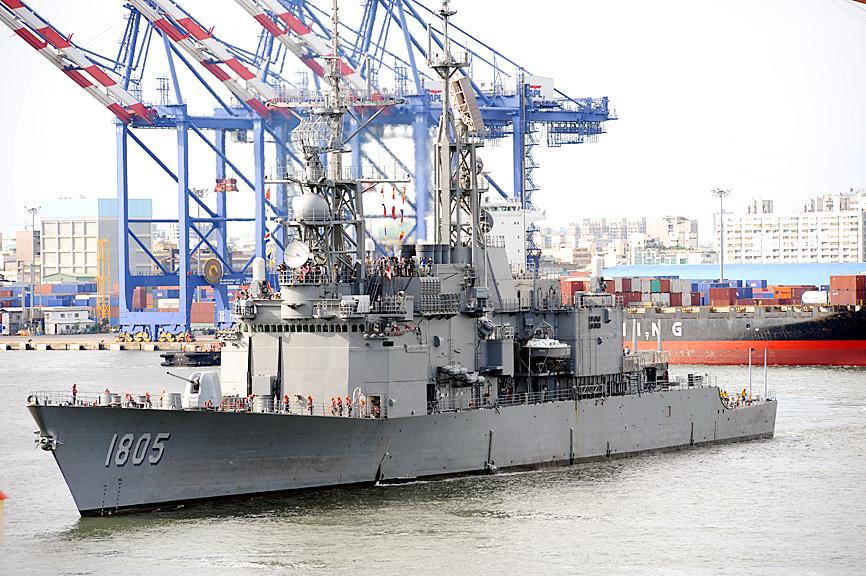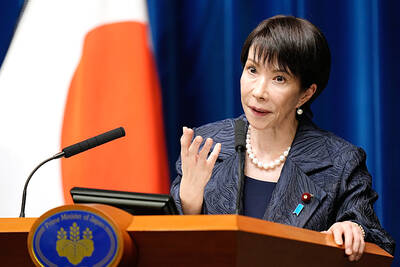China appears to have built mockups of a port in northeastern Taiwan and a military vessel docked there, with the aim of using them as targets to test its ballistic missiles, a retired naval officer said yesterday.
Lu Li-shih (呂禮詩), a former lieutenant commander in Taiwan’s navy, wrote on Facebook that satellite images appeared to show simulated targets in a desert in China’s Xinjiang region that resemble the Suao naval base in Yilan County and a Kidd-class destroyer that usually docks there.
Lu said he compared the mockup port to US naval bases in Yokosuka and Sasebo, Japan, and in Subic Bay in the Philippines, but it more closely resembles Suao.

Photo: Chang Chung-yi, Taipei Times
The South China Morning Post on Thursday quoted Lu as saying that the mockup vessel resembled one that was based in northeast Taiwan and some Guam-based US vessels.
“The mockups and drills suggest that Chinese People’s Liberation Army warships are simulating precision strikes on the Guam naval base and the Suao military port using China’s YJ-21 anti-ship missiles,” the newspaper quoted him as saying.
“A site with full-scale piers and a destroyer-sized ship-like target was constructed in December [last year],” said a report published on Wednesday on the US Naval Institute Web site, an independent forum.
“A test missile hit ... dead-center on the ship replica in February” at the Taklamakan Desert site and the target was quickly disassembled “and is now gone,” the Web site reported.
In November last year, satellite images showed that China was building targets that simulated a US aircraft carrier and other US warships in the desert to test its hypersonic anti-ship ballistic missiles, including YJ-21s, which are an increasingly significant threat to vessels, it said.
Images of the sites were in satellite images that the US Naval Institute posted, but it did not name any structures that the mockups might have been modeled after.

The Ministry of Foreign Affairs (MOFA) yesterday voiced dissatisfaction with the Comprehensive and Progressive Agreement for Trans- Pacific Partnership (CPTPP), whose latest meeting, concluded earlier the same day, appeared not to address the country’s application. In a statement, MOFA said the CPTPP commission had "once again failed to fairly process Taiwan’s application," attributing the inaction to the bloc’s "succumbing to political pressure," without elaborating. Taiwan submitted its CPTPP application under the name "Separate Customs Territory of Taiwan, Penghu, Kinmen and Matsu" on Sept. 22, 2021 -- less than a week after China

THE GOOD WORD: More than 100 colleges on both sides of the Pacific will work together to bring students to Taiwan so they can learn Mandarin where it is spoken A total of 102 universities from Taiwan and the US are collaborating in a push to promote Taiwan as the first-choice place to learn Mandarin, with seven Mandarin learning centers stood up in the US to train and support teachers, the Foundation for International Cooperation in Higher Education of Taiwan (FICHET) said. At the annual convention of the American Council on the Teaching of Foreign Languages held over the weekend in New Orleans, Louisiana, a Taiwan Pavilion was jointly run by 17 representative teams from the FICHET, the Overseas Community Affairs Council, the Steering Committee for the Test of Proficiency-Huayu, the

A home-style restaurant opened by a Taiwanese woman in Quezon City in Metro Manila has been featured in the first-ever Michelin Guide honoring exceptional restaurants in the Philippines. The restaurant, Fong Wei Wu (豐味屋), was one of 74 eateries to receive a “Michelin Selected” honor in the guide, while one restaurant received two Michelin stars, eight received one star and 25 were awarded a “Bib Gourmand.” The guide, which was limited to restaurants in Metro Manila and Cebu, was published on Oct. 30. In an interview, Feng Wei Wu’s owner and chef, Linda, said that as a restaurateur in her 60s, receiving an

MORE RETALIATION: China would adopt a long-term pressure strategy to prevent other countries or future prime ministers following in Sanae Takaichi’s steps, an academic said Taiwan should maintain communications with Japan, as Japanese Prime Minister Sanae Takaichi is to lead a revision of security documents, Taiwanese academics said yesterday. Tensions have risen between Japan and China over remarks by Takaichi earlier this month that the use of force against Taiwan would constitute a “survival-threatening situation” for Japan. Prospect Foundation president Lai I-chung (賴怡忠) yesterday said Takaichi’s stance regarding Taiwan is the same as past Japanese prime ministers, but her position is clearer than that of her predecessors Fumio Kishida and Shigeru Ishiba. Although Japan views a “Taiwan contingency” as a “survival-threatening situation,” which would allow its military to